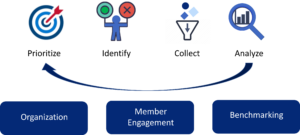 Measuring alumni engagement is essential to understand the effectiveness of your efforts and to identify areas for improvement. The key is for your institution to measure what is important to your efforts based on the goals of your institution.
Measuring alumni engagement is essential to understand the effectiveness of your efforts and to identify areas for improvement. The key is for your institution to measure what is important to your efforts based on the goals of your institution.
First level measures mostly look at attendance and online interactions which are straightforward output indicators. If you want to measure impact and deeper engagement, there needs to be additional feedback. Here are some ways to measure engagement and satisfaction:
- Participation: Go beyond attendance and try to measure active participation such as the number of questions asked or the number of people who ask questions at an event. Participation is engagement!
- Event Feedback: Collect feedback from alumni who attend events or webinars. Use surveys to gather insights into their satisfaction, suggestions, and preferences for future events.
- Newsletter Open and Click Rates: Looking at open and click rates, determine the content and format that are of greatest interest to your alumni.
- Alumni Giving: Monitor the timing and rate of alumni contributions to fundraising campaigns in relation to events, programs, and communications. There is evidence that engaged alumni are more likely to support the institution financially.
- Alumni Mentoring Programs: If you have a mentoring program, measure the participation of both mentors and mentees. This could include the number of mentoring relationships established and the duration of those relationships. Mentorships create strong ties.
- Networking and Connections: Track the number of professional connections established among alumni through your online platform. This can indicate successful networking opportunities.
- In-depth Alumni Surveys: Periodically survey alumni to gather feedback on the direction and impact of the alumni effort and how it serves the institution.
- Alumni Testimonials and Stories: Keep track of the number of alumni who willingly provide testimonials or share their success stories. These stories can reflect their emotional connection and engagement with your institution.
- Referral and Recommendation Rates: Monitor the rate at which alumni refer potential students or others to your institution. This demonstrates advocacy as a form of engagement.
- Retention Rates: Analyze how many alumni continue to engage with your institution’s initiatives over time. Higher retention rates indicate sustained engagement.
- Qualitative Feedback: Develop a system for collecting qualitative feedback and sentiments expressed by alumni.
When deciding on what to measure, consider your institution’s specific priorities and goals. Combining multiple metrics and analyzing them in context will give you a more comprehensive understanding of how engaged your alumni community truly is.
Read the first post on measuring and more articles in the Alumni Relations Transformations Series at AlmaShines or the Impactrics Resources area.
Interested in developing a similar powerful platform to measure deeper engagement? Schedule a quick demo with us to explore your vision further here: https://www.almashines.io/request-demo/


